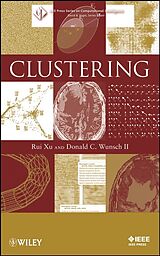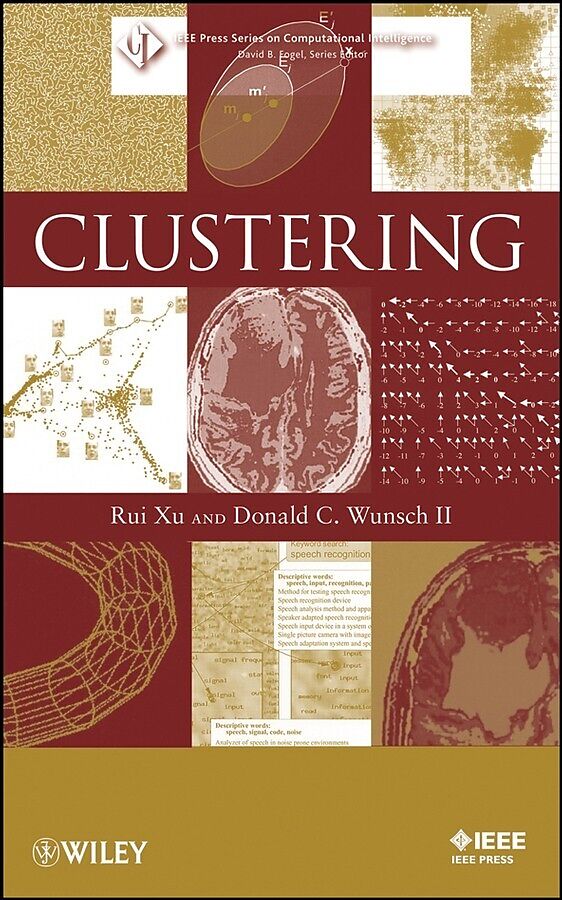Clustering
Einband:
E-Book (pdf)
EAN:
9780470382783
Untertitel:
Englisch
Genre:
Wahrscheinlichkeitstheorie, Stochastik, Mathematische Statistik
Autor:
Rui Xu, Don Wunsch
Herausgeber:
Wiley-IEEE Press
Anzahl Seiten:
400
Erscheinungsdatum:
03.11.2008
ISBN:
978-0-470-38278-3
This is the first book to take a truly comprehensive look at clustering. It begins with an introduction to cluster analysis and goes on to explore: proximity measures; hierarchical clustering; partition clustering; neural network-based clustering; kernel-based clustering; sequential data clustering; large-scale data clustering; data visualization and high-dimensional data clustering; and cluster validation. The authors assume no previous background in clustering and their generous inclusion of examples and references help make the subject matter comprehensible for readers of varying levels and backgrounds.
Autorentext
Rui Xu, PhD, is a Research Associate in the Department of
Electrical and Computer Engineering at Missouri University of
Science and Technology. His research interests include
computational intelligence, machine learning, data mining, neural
networks, pattern classification, clustering, and bioinformatics.
Dr. Xu is a member of the IEEE, the IEEE Computational Intelligence
Society (CIS), and Sigma Xi.
Donald C. Wunsch II, PhD, is the M.K. Finley Missouri
Distinguished Professor at Missouri University of Science and
Technology. His key contributions are in adaptive resonance and
reinforcement learning hardware and applications, neurofuzzy
regression, improved Traveling Salesman Problem heuristics,
clustering, and bioinformatics. He is an IEEE Fellow, the 2005
International Neural Networks Society (INNS) President, and Senior
Fellow of the INNS.
Klappentext
The only thorough, comprehensive book available on clustering From two of the best-known experts in the field comes the first book to take a truly comprehensive look at clustering. The book begins with a complete introduction to cluster analysis in which readers will become familiarized with classification and clustering; definition of clusters; clustering applications; and the literature of clustering algorithms. The authors then present a detailed outline of the book's content and go on to explore: Proximity measures Hierarchical clustering Partition clustering Neural network-based clustering Kernel-based clustering Sequential data clustering Large-scale data clustering Data visualization and high-dimensional data clustering Cluster validation The authors assume no previous background in clustering and their generous inclusion of examples and references help make the subject matter comprehensible for readers of varying levels and backgrounds. The book is intended as a professional reference for computer scientists and applied mathematicians working with data-intensive applications, and for computational intelligence researchers who use clustering for feature selection or data reduction. Its selection of homework exercises also makes it appropriate as a textbook for graduate students in mathematics, science, and engineering.
Inhalt
PREFACE.
1. CLUSTER ANALYSIS.
1.1. Classifi cation and Clustering.
1.2. Defi nition of Clusters.
1.3. Clustering Applications.
1.4. Literature of Clustering Algorithms.
1.5. Outline of the Book.
2. PROXIMITY MEASURES.
2.1. Introduction.
2.2. Feature Types and Measurement Levels.
2.3. Defi nition of Proximity Measures.
2.4. Proximity Measures for Continuous Variables.
2.5. Proximity Measures for Discrete Variables.
2.6. Proximity Measures for Mixed Variables.
2.7. Summary.
3. HIERARCHICAL CLUSTERING.
3.1. Introduction.
3.2. Agglomerative Hierarchical Clustering.
3.3. Divisive Hierarchical Clustering.
3.4. Recent Advances.
3.5. Applications.
3.6. Summary.
4. PARTITIONAL CLUSTERING.
4.1. Introduction.
4.2. Clustering Criteria.
4.3. K-Means Algorithm.
4.4. Mixture Density-Based Clustering.
4.5. Graph Theory-Based Clustering.
4.6. Fuzzy Clustering.
4.7. Search Techniques-Based Clustering Algorithms.
4.8. Applications.
4.9. Summary.
5. NEURAL NETWORK-BASED CLUSTERING.
5.1. Introduction.
5.2. Hard Competitive Learning Clustering.
5.3. Soft Competitive Learning Clustering.
5.4. Applications.
5.5. Summary.
6. KERNEL-BASED CLUSTERING.
6.1. Introduction.
6.2. Kernel Principal Component Analysis.
6.3. Squared-Error-Based Clustering with Kernel Functions.
6.4. Support Vector Clustering.
6.5. Applications.
6.6. Summary.
7. SEQUENTIAL DATA CLUSTERING.
7.1. Introduction.
7.2. Sequence Similarity.
7.3. Indirect Sequence Clustering.
7.4. Model-Based Sequence Clustering.
7.5. Applications--Genomic and Biological Sequence.
7.6. Summary.
8. LARGE-SCALE DATA CLUSTERING.
8.1. Introduction.
8.2. Random Sampling Methods.
8.3. Condensation-Based Methods.
8.4. Density-Based Methods.
8.5. Grid-Based Methods.
8.6. Divide and Conquer.
8.7. Incremental Clustering.
8.8. Applications.
8.9. Summary.
9. DATA VISUALIZATION AND HIGH-DIMENSIONAL DATA
CLUSTERING.
9.1. Introduction.
9.2. Linear Projection Algorithms.
9.3. Nonlinear Projection Algorithms.
9.4. Projected and Subspace Clustering.
9.5. Applications.
9.6. Summary.
10. CLUSTER VALIDITY.
10.1. Introduction.
10.2. External Criteria.
10.3. Internal Criteria.
10.4. Relative Criteria.
10.5. Summary.
11. CONCLUDING REMARKS.
PROBLEMS.
REFERENCES.
AUTHOR INDEX.
SUBJECT INDEX.

Leider konnten wir für diesen Artikel keine Preise ermitteln ...
billigbuch.ch sucht jetzt für Sie die besten Angebote ...
Die aktuellen Verkaufspreise von 6 Onlineshops werden in Realtime abgefragt.
Sie können das gewünschte Produkt anschliessend direkt beim Anbieter Ihrer Wahl bestellen.
Loading...
Die aktuellen Verkaufspreise von 6 Onlineshops werden in Realtime abgefragt.
Sie können das gewünschte Produkt anschliessend direkt beim Anbieter Ihrer Wahl bestellen.
| # | Onlineshop | Preis CHF | Versand CHF | Total CHF | ||
|---|---|---|---|---|---|---|
| 1 | Seller | 0.00 | 0.00 | 0.00 |
